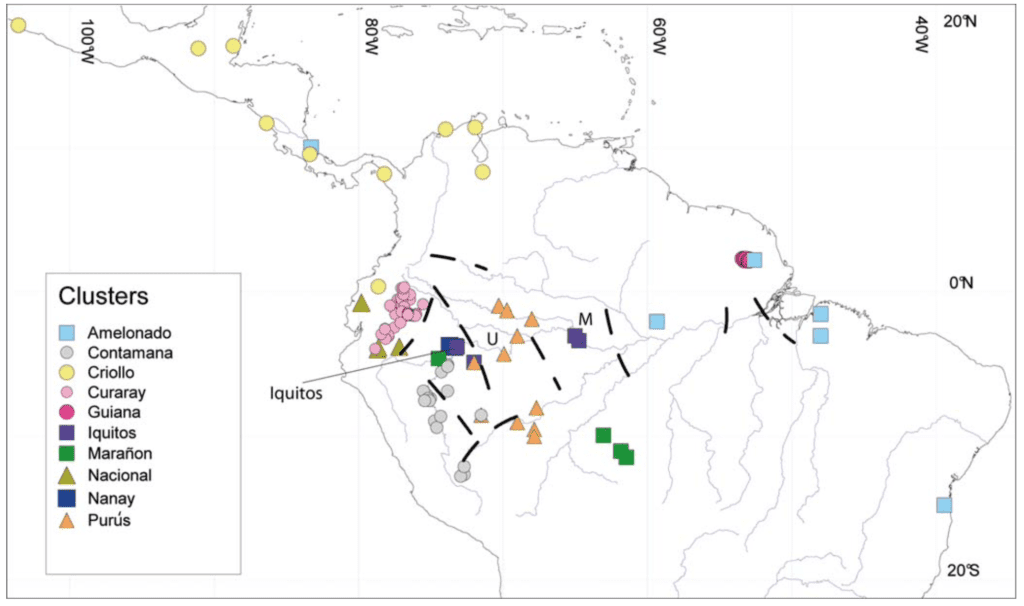A term that refers to a genetic cluster of the species Theobroma cacao. The word criollo has also been adopted to market chocolate using beans of that genetic cluster. It is also a colloquial term in Latin America.
It can therefore mean something completely different to a European chocolate maker than an Ecuadorian cacao farmer for example.
The word itself derives from the Spanish word for “native.” Farmers in Latin America may use the term to describe their own cacao that is native to that region, or that has been grown in that area for a long time. By saying criollo it does not necessarily mean that these farmers grown cacao beans of the genetic cluster Criollo.
Until recently, Theobroma cacao was classified into three genetic groups: Criollo, Trinitario, and Forastero. Criollo was considered superior cacao, whereas Forastero was considered bulk cacao and Trinitario a combination of Criollo and Forastero. However, in 2008, researcher Juan Motamayor concluded that there are actually ten different identifiable genetics clusters: Amelonado, Contamana, Criollo, Curaray, Guiana, Iquitos, Marañon, Nacional, Nanay and Purús.
The Criollo genetic cluster produces, as oftentimes believed, white- or cream-coloured beans, which have a reputation for a more delicate flavour than other varieties. Chocolate companies therefore oftentimes claim to sell chocolate solely made using “Criollo” beans.
Or, when one variety is mentioned on a chocolate bar, it can oftentimes mean that the cacao beans used have a larger proportion of one specific gene than others. However, genetic testing usually shows that the cacao tree has mixed genetics from different clusters.
However, this does not mean that no pure criollo exists.
As Dan O’Doherty mentions, there is indeed pure criollo and it is actually easy to identify genetically. Pure criollo accessions, even with very different phenotypes, are entirely, 100% homozygous at all genotypic loci.
Grown in isolation or propagated vegetatively, it is possible to maintain a pure collection of ancient criollo. For example, Jake Marlin from BFREE maintains a collection in Belize and Dan O’Doherty himself has 7 different strains in Hawaii.
Próximamente versión en español

Entry added: February 2, 2023
Verified on: September 14, 2023
Authored by
Tara Durieux, anthropologist and Fine Chocolate Glossary manager
Academic / university faculty
References
Making Chocolate: From Bean to Bar to S’more, Todd Masonis, Greg D’ Alesandre, Lisa Vega and Molly Gore, New York: Clarkson Potter, 2017.
“Geographic and Genetic Population Differentiation of the Amazonian Chocolate Tree (Theobroma cacao L),” Juan C. Motamayor, Philippe Lachenaud, Jay Wallace da Silva e Mota, Rey Loor, David N. Kuhn, J. Steven Brown and Raymon J. Schnell, PLoS ONE, 2008.
The New Taste of Chocolate: A Cultural and Natural History of Cacao with Recipes, Maricel E. Presilla, Berkeley: Ten Speed Press, 2009.
“Learn more about Cacao Genetics!,” Uncommon Cacao, December 16, 2020.
“The Biggest Misconceptions On Cacao Varieties Demystified,” The Chocolate Journalist, May 13, 2017.
Personal communication: explanation on genetics and pure criollo by Dan O’Doherty, March 2023.
Have a comment on this definition?
